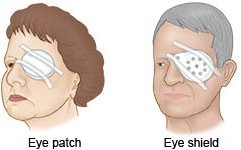The nurse is performing tracheostomy care for a client when a code blue is called for another client on the unit who experiences a cardiopulmonary arrest. Which action should the nurse take?
Call for an assistant.
Respond to the code.
Finish the procedure.
Close the room door.
The Correct Answer is A
Tracheostomy care is done to keep the trach tube clean and prevent infections. It involves suctioning and cleaning parts of the tube and the skin around the stoma. A code blue is a hospital emergency code that indicates a life-threatening situation, such as cardiac or respiratory arrest. It requires immediate attention from trained personnel.
- Call for an assistant to stay with the client who is receiving tracheostomy care and continue the procedure.
- Respond to the code blue and assist with resuscitation efforts for the other client.
- Return to the client who is receiving tracheostomy care as soon as possible and complete the procedure.
Therefore, the correct answer is a. Call for an assistant.
Nursing Test Bank
Naxlex Comprehensive Predictor Exams
Related Questions
Correct Answer is B
Explanation
After retinal detachment surgery, it is crucial to protect the eye and the surgical repair site from accidental trauma or pressure. Providing an eye shield helps to shield the eye during sleep when the client may not have conscious control over their movements.
This can help prevent inadvertent rubbing or bumping of the eye, which could potentially disrupt the surgical repair and hinder the healing process.
Obtaining vital signs every 2 hours during hospitalization is a routine nursing intervention for postoperative care in general but is not specific to retinal detachment surgery. The frequency of vital sign monitoring may vary depending on the client's overall condition and the healthcare provider's orders.
Teaching a family member to administer eye drops may be necessary for the client's ongoing care, but it is not specifically related to the immediate postoperative period. Eye drop administration instructions can be provided as part of the client's discharge teaching.
Encouraging deep breathing and coughing exercises is a general postoperative intervention that promotes respiratory function and helps prevent complications such as pneumonia. While important for overall postoperative care, it is not specific to retinal detachment surgery.

Correct Answer is A
Explanation
The information that the nurse should obtain from the client first is: Reason for taking the aspirin.
It is important to first understand why the client was taking aspirin in order to determine the potential implications of switching to ibuprofen. Aspirin and ibuprofen are both nonsteroidal anti-inflammatory drugs (NSAIDs), but they have different indications and effects. Aspirin is commonly used for its antiplatelet properties to reduce the risk of heart attacks and strokes, while ibuprofen is primarily used for its analgesic and anti-inflammatory properties.
By understanding the reason for taking aspirin, the nurse can assess if the client was using it for its antiplatelet effects, which is important information to consider for the client's overall health and well-being.
Once the reason for taking aspirin is determined, the nurse can proceed to inquire about the other relevant information, such as the dosage of ibuprofen taken, presence of gastric pain, and amount of pain control. These details will help in assessing the client's current medication regimen, potential side effects or complications, and overall pain management.
Whether you are a student looking to ace your exams or a practicing nurse seeking to enhance your expertise , our nursing education contents will empower you with the confidence and competence to make a difference in the lives of patients and become a respected leader in the healthcare field.
Visit Naxlex, invest in your future and unlock endless possibilities with our unparalleled nursing education contents today
Report Wrong Answer on the Current Question
Do you disagree with the answer? If yes, what is your expected answer? Explain.
Kindly be descriptive with the issue you are facing.
